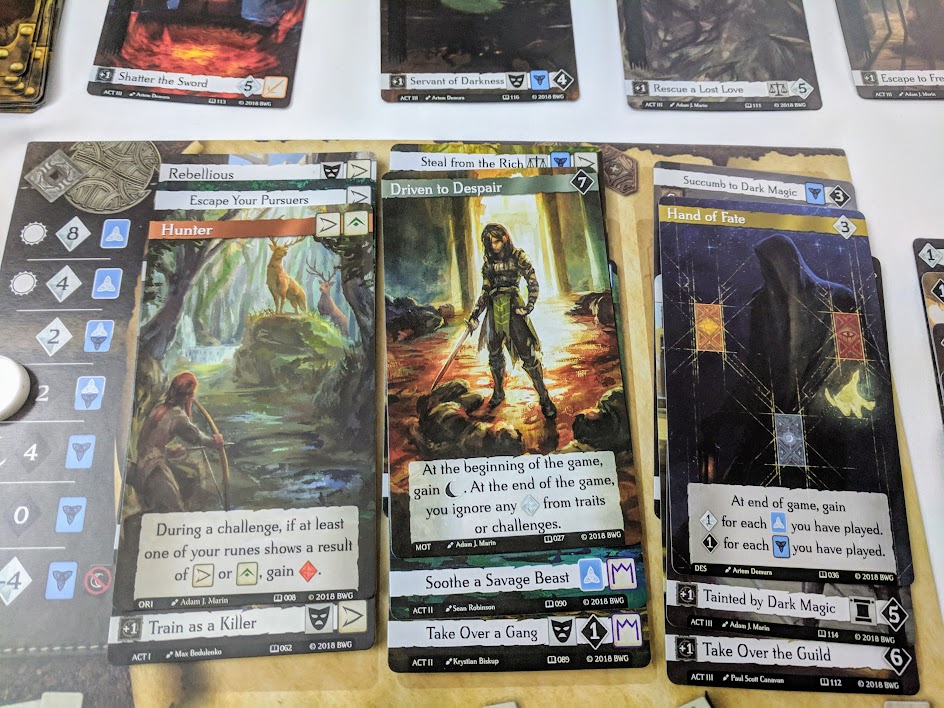We received a review copy of Call to Adventure. All thoughts and opinions shared are our own.
Do you long for adventure? Do you wonder what led game characters to where they are now?
We love to play games with characters embarking on heroic journeys, but we also like to make up stories about how they got there.
If you enjoy a bit of storytelling in your gaming, then you'll want to check out Call to Adventure by Brotherwise Games.
This post also contains affiliate links, which means we may earn a small commission if you make purchase.
What is Call to Adventure?
Call to Adventure is a tabletop game by Brotherwise Games. It is designed for 1-4 players and plays in about 30-60 minutes. It includes solo and co-op variant setup and rules as well.
In Call to Adventure, you are building a character's story. Starting with their origin, you gain traits and abilities while facing challenges as you play to reach their destiny.
How Do You Play Call to Adventure?
Below is an overview of how to play and you can also watch our two player learning playthrough to get a better sense the gameplay.
Each player has three acts to their story: Origin, Motivation, and Destiny.
All players can see your character's Origin and Motivation, but your Destiny remains face down. This adds a bit of intrigue as to what type of story line you are working towards for final scoring.
You begin the game with a number of Act I cards face up from the story deck. There are two types of cards: Traits and Challenges.
Traits can be acquired by meeting certain criteria or purchasing them with experience tokens.
Challenges have two paths – one tends to lead toward a darker, tragic hero story.
One of the interesting parts of this game is that you cast runes instead of rolling dice. I like the tactile feel of the runes and it fits the theme of this game very well.
You cast the core set of runes plus ability runes that match abilities your character has gained throughout the game. There are also Dark Runes that you may use, but they come with a a cost and the risk of corruption.
The Hero and Antihero cards can assist you throughout your journey, but they are not part of your story.
Using the Story Decks

To progress through your story, you must collect three cards for each Act. Like a play, Act I must be complete before you move on to Act II.
Once a player has claimed three story cards from Act I, that act is closed to that player and the must now work on collecting Act II cards.
The first player to complete Act I will reveal the Act II cards. Any player may try to collect those cards. This means some players may have Act II story cards in their character's Act I Origin story.
This is OK! Act II cards are often more difficult to acquire than Act I, but they can help other players “catch up” in a sense with points.
This way, a player isn't necessarily at a disadvantage if they didn't close out the act before any other player.
How to Win Call to Adventure
The end of the game is triggered when a player has collected three cards under their Destiny card, completing Act III. The rest of the players get one final turn before scoring.
The player with the highest Destiny score wins! This may or may not be the player who completed all three chapters of their story.
After scoring, each player takes turns telling their character's story using the character and story cards. What was their origin backstory? What was their motivation? How did they achieve their destiny?
This is one of the best parts of the game, especially if you enjoy creating backstories for your characters.
Call to Adventure Game Variations
Now that you've gotten the hang of the base game, it's time to shake those hero stories up.
Included in the game are Allies and Adversaries. It's recommended to play without them the first few times so you can learn the basic gameplay.
The Allies and Adversaries are shuffled in with the story decks to enhance the game and storytelling.
Allies become assigned to revealed challenges. You gain the ally by succeeding at the challenge. They can provide additional powers for you to use throughout the game.
Adversaries are special challenges where you must defeat the Adversary.
The core rules are for playing competitively against other players, but you can also play Call to Adventure solo or as a cooperative game.
The rule book includes the set up and changes to the gameplay for these variant rules.
Can You Play Call to Adventure With Kids?
The short answer: it depends, but yes.
The age on the box says 13+, but we use that as a loose guideline. It's going to depend on your individual child, their interests, and their abilities.
Overall, I would say yes and here's why.
My 8 year old daughter enjoys playing Call to Adventure with us. She likes reading, being creative, and storytelling. She's also been gaming with us since she was little and is used to a variety of game mechanics and strategy.
She's now able to join us for longer games and while this game is competitive, it doesn't have an aggressive feel to the gameplay.
The artwork is gorgeous. I have not seen any cards containing images I consider inappropriate.
Some kids may need assistance throughout the game, but you could also play the Call to Adventure cooperative game variation instead of playing competitively.
I do not recommend playing this game with younger kids if they have trouble sitting and being focused for longer games. We have not played this with our 6 year old yet, but he's welcome to join us at the table when he shows an interest in the game.
You will definitely want to play through the game on your own first so you can show your child how to play rather than reading the rules to them.
Where to Buy Call to Adventure
Call to Adventure is available at many friendly local board game stores (also known as FLGS) as well as Barnes & Noble. You can also order Call to Adventure on Amazon.
Call to Adventure Board Game


